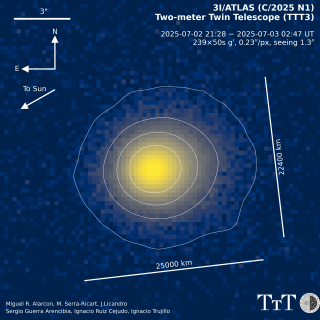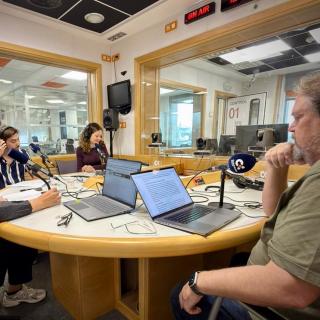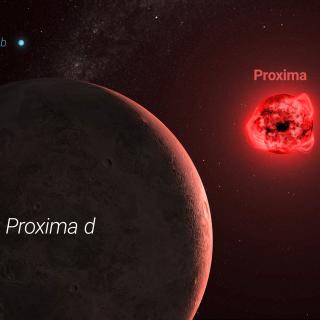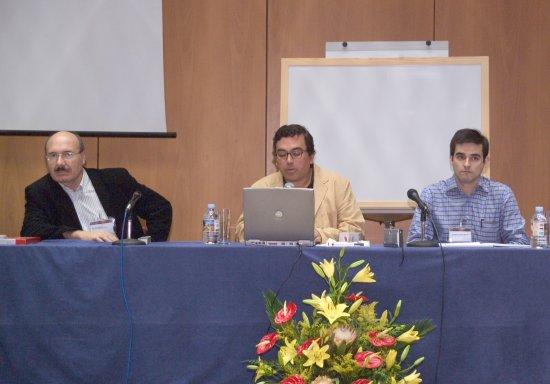It may interest you
-
 The Instituto de Astrofísica de Canarias (IAC) is actively participating in the observation of object 3I/ATLAS (C/2025 N1 ATLAS), initially included as A11pl3Z in the confirmed list of Near-Earth Objects (NEOs) of the International Astronomical Union's Minor Planet Centre (IAU/MPC). The object, which has been shown to be the third interstellar object detected in our solar system, was discovered by one of the telescopes in the ATLAS network for the detection and early warning of asteroids on an Earth-impact trajectory. The IAC is part of this network with its new telescope structure, ATLASAdvertised on
The Instituto de Astrofísica de Canarias (IAC) is actively participating in the observation of object 3I/ATLAS (C/2025 N1 ATLAS), initially included as A11pl3Z in the confirmed list of Near-Earth Objects (NEOs) of the International Astronomical Union's Minor Planet Centre (IAU/MPC). The object, which has been shown to be the third interstellar object detected in our solar system, was discovered by one of the telescopes in the ATLAS network for the detection and early warning of asteroids on an Earth-impact trajectory. The IAC is part of this network with its new telescope structure, ATLASAdvertised on -
 El programa de divulgación científica del Instituto de Astrofísica de Canarias (IAC) en La Radio Canaria, "Soñando Estrellas", emitirá su próximo episodio, este viernes, 28 de noviembre, a las 22:30 horas. El espacio, de 30 minutos de duración, está dirigido y presentado por Verónica Martín, jefa de la Unidad de Comunicación y Cultura Científica (UC3) del IAC. En este episodio la investigadora del IAC, Cristina Ramos Almeida, responderá a la pregunta de cómo nacen y crecen las galaxias y, especialmente, a cómo mueren. La investigadora, que recientemente recibió el Premio Mujer Tenías que SerAdvertised on
El programa de divulgación científica del Instituto de Astrofísica de Canarias (IAC) en La Radio Canaria, "Soñando Estrellas", emitirá su próximo episodio, este viernes, 28 de noviembre, a las 22:30 horas. El espacio, de 30 minutos de duración, está dirigido y presentado por Verónica Martín, jefa de la Unidad de Comunicación y Cultura Científica (UC3) del IAC. En este episodio la investigadora del IAC, Cristina Ramos Almeida, responderá a la pregunta de cómo nacen y crecen las galaxias y, especialmente, a cómo mueren. La investigadora, que recientemente recibió el Premio Mujer Tenías que SerAdvertised on -
 The new infrared spectrograph NIRPS, built with the participation of the Instituto de Astrofísica de Canarias (IAC) and installed on the 3.6-metre telescope at ESO’s La Silla Observatory in Chile, has achieved its first scientific results, with four articles published today in the journal Astronomy & Astrophysics and one more accepted for publication. The data confirm its ability to detect Earth-like planets in the infrared for the first time with a precision better than one metre per second. One of the papers, led by IAC researcher Alejandro Suárez Mascareño, confirms the presence of aAdvertised on
The new infrared spectrograph NIRPS, built with the participation of the Instituto de Astrofísica de Canarias (IAC) and installed on the 3.6-metre telescope at ESO’s La Silla Observatory in Chile, has achieved its first scientific results, with four articles published today in the journal Astronomy & Astrophysics and one more accepted for publication. The data confirm its ability to detect Earth-like planets in the infrared for the first time with a precision better than one metre per second. One of the papers, led by IAC researcher Alejandro Suárez Mascareño, confirms the presence of aAdvertised on
